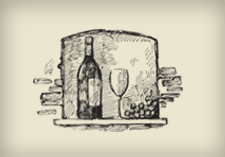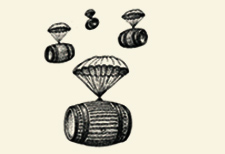This I Believe
I was listening to NPR the other day. They have a feature in which people talk about their core values, how they feel about family, democracy, truth, justice, government, foreign policy, et cetera. None of these people has yet to discuss important issues, like barrels and wine, so I thought it was time to set the record straight about what makes a barrel good, great, bad or indifferent.
What are the factors in wine barrel quality? My call:
Species of oak and region of origin
Method of seasoning/drying.
Manufacturing techniques.
The species used for barrels is the most important oak flavor determinant.
There are hundreds of species of oak, all of which can be broadly separated into two categories, red and white. The red oaks leak. This is bad. For wine three sorts of white oak are most important, one American and two European, all of them belonging to the botanical sub-group Euquercus:
Quercus alba, also known as American white oak. This general name is also applied to other American oak species, including Quercus bicolor, swamp white oak; Quercus lyrata, overcup oak; Quercus durandii, Durand oak; Quercus michauxii,swamp chestnut oak; and Quercus prinus, chestnut oak. Some of these species can hybridize with each other.ea. This species tends to produce tight-grained oak. Its crown forms high on the tree and is relatively tight.
Quercus sessiliflora, also known as sessile oak, Quercus rouvre or Quercus petraea. This species tends to produce tight-grained oak. Its crown forms high on the tree and is relatively tight.
Quercus robur, also called pedunculate or variously English, French and Russian oak. This species looks like a classic English oak tree, with a wide crown that forms relatively low. The wood from this species is wide-grained.
The latter two species are grown all over Europe. The differences between American and European species are quite dramatic. Within the category of species, we have the effects of soil and climate. In France, a country the size of Texas, we talk of different regions: Nevers, Allier,Vosges, Limousin, etc. Yet in American oak we are just beginning to look at geographical variations.
Note that oak grain in French oak is a function of species. Quercus sessile tends to be tight grained, whereas quercus robur has wider grains. Vosges is mostly quercus sessile but it grows faster and has wider grain. The wider grained wood tends to taste more tannic so this needs to be air dried longer than the tight-grained wood. Is grain width for American oak as important as it is for European?? This is not clear. Most of the time people are using a false analogy when tight-grained American oak is compared to tight-grained French.
Air Drying Versus Kiln Drying
It could be argued that air-drying is more important than species. An American oak barrel made with well-seasoned staves can perform better than a European oak barrel made with 'green' oak.
Wines, particularly wines naturally low in tannins themselves, can taste aggressively tannic after being matured in barrels made from kiln-dried, as opposed to air-dried, wood. It was assumed that air-drying extracts some wood tannins. Where wood is being seasoned one can see a black substance on the ground and this was assumed to be tannin excreted by the wood. French, American and Australian research suggests that seasoning may be a much more complex process than was previously thought.
One researcher in Australia concluded that although hydrolysable tannin was not reduced during season, the threshold for tasting tannins went up significantly. In other words, as far as the consumer is concerned, air-drying makes for a smoother wine.
Natural air seasoning is crucial. Is air-drying is the second most or THE important oak flavor determinant? The role of air-drying should not be under estimated.
A secondary question is where was the wood dried?? The saying that wood should be dried where it grows applies here. Drying the wood under hot and dry conditions is not the best scenario.
The third most important quality factor: How the barrel is made:
To make a barrel, oblong lengths of woods are heated and bent. How this is done has a profound influence on wine flavor. Natural gas, steam, boiling water, wood fire, and a combination of these techniques are used.
Shaping the barrel over a wood fire is the techniques that most profoundly impacts flavor. Wood fire inevitably toasts the inside of the barrel to a degree that varies according to the heat of the fire and the length of time the barrel is over it.
Virtually every cooperage gives its customers a choice of toasting combinations. Many cooperages talk about this aspect of barrel making because it is the most visible
What is not commonly discussed is how air-drying impacts the flavor of the toasting. If the wood is not properly seasoned, aromas more commonly associated with barbequed meats can dominate the wine. The longer the wood is air-dried, the less obvious the toastiness. Sometimes when barrels are criticized for excess toastiness, it is the seasoaning that is really objectionable.
Moreover, the impact of the toasting is important the first twelve months of the barrel's use. After that the importance of toasting diminishes while seasoning remains key.
Is stave width important?? How important is it that a barrel be made with thin or thicker staves?? The jury is out, but only in a context of properly dried staves. Given the choice between well-seasoned thick staves and improperly dried thin staves, the choice is easy to make. Stave thickness is minor compared to stave seasoning.
Barrel shape?? This is certainly important to the cellar staff. Of course, different shapes give different body stave-to-head stave ratios, and handle lees differently. Again, this is not important as stave seasoning.
What is the right barrel?? It's the one that tastes best with your wine. Theoretical arguments are fun, but the proof is in the taste!

